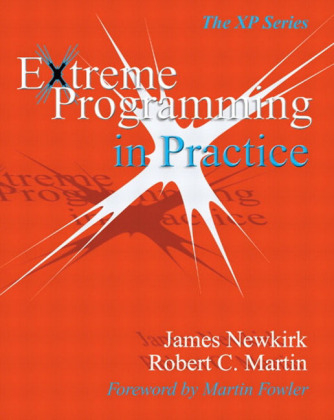
Extreme Programming in Practice
Addison Wesley (Verlag)
978-0-201-70937-7 (ISBN)
- Titel ist leider vergriffen;
keine Neuauflage - Artikel merken
Extreme Programming (XP) is a lightweight methodology that enables small teams of developers to achieve breakthrough productivity and software quality, even when faced with rapidly changing or unclear requirements. In this new book, top object-oriented consultants James Newkirk and Robert Martin walk through an entire XP project, chronicling the adoption of XP by a team that has never used it before. Along the way, they show how to overcome the obstacles facing XP adopters, and present realistic XP best practices virtually any development organization can benefit from. The case study in this book is real, driven by the needs of a real customer. The artifacts, code, user stories, and anecdotes are all real, drawn from videotaped meetings throughout the project's development process. The result: an exceptionally true-to-life narrative, complete with mistakes and false starts, and reflecting the ebb and flow of a real project. For organizations considering XP, this may be the most realistic and useful guide ever produced. For project managers, developers, software engineers, XP customers, and upper-level managers.
James Newkirk is a principal in a consulting firm named Object Mentor, based in Illinois. Object Mentor provides software leadership services to the global community. They use XP process improvement, OO design consulting, and the skills that come with experience to help companies get their projects done. Robert C. Martin has been a software professional since 1970 and an international software consultant since 1990. He is founder and president of Object Mentor, Inc., a team of experienced consultants who mentor their clients in the fields of C++, Java, OO, Patterns, UML, Agile Methodologies, and Extreme Programming.
Preface.
1. The Skinny.
The First Solution.
Changes.
What Went Wrong?
2. Playing to Win.
Extreme Programming (XP).
The Structure of This Book.
3. What is XP?
Introduction.
Exploration.
Spike.
Release Planning.
Iteration Planning.
Development.
The Story of a Story.
4. Exploration.
The Story of Some Constraints.
Architecture.
An Expensive Story.
Combining Stories.
Registration Story.
Existing User.
Legacy Conversion.
Notification.
Registration Pages Look and Feel.
Miscellaneous.
Conclusion.
Summary of Stories.
5. Planning.
Prioritizing the Stories.
Architectural Significance.
Release and Iteration Duration.
Velocity.
Planning the First Release.
Conclusion.
6. The First Iteration Plan.
Breaking Stories into Tasks.
Signing Up for Tasks.
Estimating the Tasks.
Conclusion.
7. Beginning the First Iteration.
Plans Are One Thing, Reality Is Another.
Starting the Iteration.
Conclusions.
Tracking.
8. Task #3, Login Task.
Cookies.
Tracking.
9. A Flurry of Refactoring.
Conclusions.
Tracking.
10 retpahC. sdrawkcaB gnikroW.
TestNoUser.
TestGoodEmail.
TestBadEmail.
Implementing the Mock-Objects.
ForgotPassword Servlet.
Conclusion.
Tracking.
11. Infrastructure Thrashing.
Refactoring the Tests.
Refactoring the Database—again.
Infrastructure Revolution.
The Registration Servlet.
Conclusion.
Tracking.
12. Iteration I-Summary.
Cookie Woes.
HTML/JSP Tasks.
We Thought We Were Done.
13. Steering.
An interesting Misunderstanding.
What Went Wrong?
14. Finishing the Release.
Can't You Fit Two Hours?
Task Planning.
The Iteration.
Lessons Learned.
The Third Iteration and Release.
Release.
Projecting This Experience onto Larger Projects.
15. Conclusion.
Lessons Learned.
Final Conclusions.
Appendix A. Iteration 1—Code.
Index.
| Erscheint lt. Verlag | 13.6.2001 |
|---|---|
| Verlagsort | Boston |
| Sprache | englisch |
| Maße | 187 x 234 mm |
| Gewicht | 465 g |
| Themenwelt | Informatik ► Software Entwicklung ► Agile Software Entwicklung |
| ISBN-10 | 0-201-70937-6 / 0201709376 |
| ISBN-13 | 978-0-201-70937-7 / 9780201709377 |
| Zustand | Neuware |
| Haben Sie eine Frage zum Produkt? |
aus dem Bereich


